
Food is our common ground, a universal experience.
—James Beard
Chapter 2
Managing a gluten-free diet increases the level of complexity involved in eating outside the home, particularly in restaurants. It requires a higher level of education, understanding and planning compared to the general public who, in most cases, can easily eat whatever they want, wherever they want. Knowing what foods are safe is of the utmost importance.
The suggestions outlined in this chapter are designed to give guests a greater sense of comfort when venturing beyond their front door to eat out while, at the same time, assisting restaurants in safely serving guests with special dietary concerns. Therefore, the approach to safe eating experiences entails an understanding of the:

There is a learning curve for individuals who are guests in eating establishments managing gluten-free diets as well as for the restaurants who cater to them. The process of gaining the necessary knowledge to successfully handle special dietary requirements is similar for both parties.
The learning curve associated with special diets includes the following four key steps, for individuals and restaurant professionals alike:

1. To gain awareness, you, as an individual, need to first educate yourself to understand exactly what special diet you are required to follow. You may be asking, “What have I been diagnosed with? Where do I begin my research? What resources are available to me and what do I do next?” These are all common questions associated with learning about your new way of life.
On the other side of the table, restaurant professionals go through a similar experience. “What type of special diets may be required by our guests? What do we need to learn to better understand their needs? What resources are available to help us?”
2. The next step in the learning curve is information. As an individual, you must learn what you can and cannot eat on a fundamental level. Once this is understood, it is important to investigate where problematic gluten and wheat can be hidden in foods and what you need to do to adjust for this unexpected variable.
Likewise, restaurant professionals follow a similar thought process. “What can this guest eat and what is not allowable? What ingredients and food preparation techniques can be an issue and how can we adjust to suit their requirements?” The parallel is undeniable.

3. Once this understanding is accomplished, the third step is knowledge. Individuals need to apply what has been learned to safely eat in restaurants, as well as at home. Furthermore, you must learn to communicate your special requirements and determine an effective strategy for ordering safe meals in order to develop a comfort level with various cuisines and dishes.
As a restaurant, you have a different set of concerns to address, such as how to train both front and back of the house staff. You also need to determine how to accurately convey this information between all employees involved in the process and identify what protocols need to be in operation.
Through effective training efforts, an establishment can teach their staff how to assist special diet guests by guiding them through the menu, taking into consideration ingredients, preparation techniques and hidden gluten or wheat concerns.
4. The final step of the learning curve is empowerment. As the guest, you need to know where and what you can eat, as well as what modifications can be made to easily accommodate your dietary requirements. Once this is achieved, you can focus on enjoying your eating experiences while remaining diligent about the foods you eat.
For the restaurant, the focus becomes how to simplify menu options to adjust for special dietary needs. This allows the restaurant to concentrate on providing safe and delicious meals for their guests, while ensuring a high standard of service, ultimately resulting in repeat and loyal business.
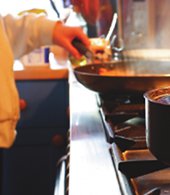
Based upon years of research, personal experience and extensive discussions with hospitality professionals, the following approach is designed to help you, the person managing a gluten-free lifestyle, eat out safely. The objective is to enjoy safe eating experiences regardless of your choice of restaurant, cuisine or location. These suggestions include eight key steps on how to safely eat outside the home:

Each of these eight key steps are described in detail to guide you in developing your own approach to eating outside the home. The questions to ask yourself, as the guest, may be helpful in assessing your level of preparedness along the way. If you are new to your diet, these ideas may give you some food for thought during the early stages of your learning curve.
For those who have been following a gluten-free diet for some time, you might find it interesting to reflect upon your previous experiences, correlate them to this recommended approach and, perhaps, learn something new in the process. These ideas are also provided for restaurants who want to understand the guest’s perspective of how to handle special dietary needs.
1. Educate yourself about eating outside the home with special diets
a. Read applicable materials:
• Review books, publications, restaurant reviews and awareness programs
• Research the Internet, databases and other reference materials
b. Talk with other individuals managing gluten-free lifestyles
c. Attend educational sessions:
• Participate in associated conferences and cooking classes
• Hire a personal chef for consultation
Questions for Guests:
Do I have the information that I need to make informed choices and increase my comfort level in restaurants?
What additional research is required to expand my knowledge?
2. Assess your dining comfort level for the meal
a. Identify your safety factors:
• Determine how you feel physically
• Assess how safe you feel with eating out
b. Based upon your previous needs and experiences, evaluate what cuisines are low and high risk
c. Assess specific cuisines:
• Determine what type of cuisines satisfy your comfort level and tastes
• Identify your desired level of understanding about food preparation techniques
Questions for Guests:
How comfortable do I feel eating out in restaurants today?
What foods appeal to me?
How safe do I feel today with the food that I will be eating?
3. Identify your eating options and preferences
a. Determine the desired type of establishment:
• Fine dining or family-oriented restaurant
• Fast food/quick service or carry out/take away
b. Assess what type of cuisine you prefer:
• New and different
• Familiar with cuisine menu items
c. Determine important factors based on your comfort level:
• Recommended and new restaurant
• Familiar and where you have eaten before
• Features specific gluten-free menu
d. Select your restaurant
Questions for Guests:
How much effort do I want to spend on deciding what to eat?
How comfortable am I with this restaurant, the cuisine and menu options?
4. Determine desired level of pre-planning efforts
a. Conduct research as necessary on:
• Cuisine ingredients and preparation techniques
• Potential hidden gluten or wheat
• Restaurant menu options and items
b. Determine the best time for your meal:
• Decide to walk into a restaurant when convenient
• Reserve a desired time
• Reserve a time that is typically not crowded
c. Determine the level of communication necessary with the restaurant prior to your meal:
• None required
• Review menu on the Internet
• Call ahead to discuss your requirements
Questions for Guests:
What level of planning do I want to do prior to going to the restaurant?
What areas of food preparation need to be reviewed?
What items containing gluten or wheat do I need to be aware of?
Do I need to conduct more research to increase my comfort level about this cuisine and/or restaurant?
5. Communicate your special dietary needs with the restaurant
a. Determine your approach:
• Susceptible to anaphylaxis and life threatening conditions
• Have celiac / coeliac or wheat allergies
• On a special diet
b. Initiate your first contact with restaurant:
• Go to restaurant without prior communication
• Call ahead prior to walking in the door
• Pre-order your meal based upon your concerns
c. Discuss requirements with restaurant staff and potentially request manager or chef if needed
Questions for Guests:
How do I want to communicate the severity of my condition?
When and how do I want to explain my special dietary needs?
Are my requirements understood or do I need to speak with someone else to feel safe and comfortable?
6. Order your meal
a. Determine reference materials required to order meal:
• Assess if a dining card outlining dietary requirements is needed based upon your comfort level or language considerations
• Refer to your notes, books, quick reference guides, translation cards and foreign language phrase books as needed
b. Discuss the menu with the restaurant:
• Ask appropriate questions to determine meal choices based upon cuisine, dishes and preferences
• Explain your concerns to the restaurant
• Ask staff to verify and validate ingredients and preparation techniques as needed
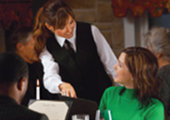
c. Place your order:
• Request special food preparation
• Confirm your order with restaurant
Questions for Guests:
How do I want to communicate my needs to the restaurant—ask questions, give them materials outlining requirements or both?
What areas of food preparation need to be questioned?
How comfortable do I feel that my order will be prepared as requested?
7. Receive order and appreciate your meal
a. Confirm your order upon delivery:
• Reiterate your special order request
• Receive dish and assess preparation
b. Enjoy your meal:
• Accept the dish
• Request dish be returned if special request is not met
c. Relax and appreciate the dining experience:
• Compliment the staff if your special requests are met
• Include a generous tip for good service, if appropriate
• Frequent the restaurant again based on experience
Questions for Guests:
Is my meal what I ordered?
If not, what needs to be modified to correct the order?
Would I return to this restaurant?

8. Provide feedback on dining experience
a. Provide constructive feedback to restaurant professionals on your eating experience
b. Recommend the establishment to your friends and family, as appropriate
c. Notify applicable on-line database resources and/or restaurant awareness programs about your experience
Questions for Guests:
What do I want to communicate to the staff regarding their service?
Would I recommend this establishment to others?
Knowledge and understanding coupled with clear table-side communication are the keys to ensuring safe, enjoyable gluten-free experiences for guests. Again, appropriate training on procedures for handling special diets needs to be in place. Establishing protocols for special dietary needs provides consistent dining experiences for each and every gluten-free guest.

In order to achieve the optimal collaborative process with guests who have special dietary needs, there are seven important steps to take to prepare your operation for safe, happy and healthy guests.
Each of these suggestions are compiled into a checklist for restaurants to help ensure that the special dietary requirements of your guests are being addressed. The questions to ask yourself, as the restaurant, assess training effectiveness and the level of preparedness in handling special requests. These ideas are provided for eating establishments catering to gluten-free guests, as well as for those individuals who want to understand the restaurant’s perspective to handling their special needs.
1. Educate staff about special dietary requirements
a. Conduct training for management and staff on special diets
b. Monitor training effectiveness and guest feedback
c. Implement standard protocols for special diets
Questions for Restaurants:
Is the staff knowledgeable about special diets?
What are the current restaurant trends about special diets?
What training can we implement to improve awareness?
2. Identify restaurant-specific ingredients and food preparation techniques to be potentially modified for special diets
a. Identify ingredients and food preparation considerations
b. Identify which menu items are naturally free of gluten and wheat
c. Explore potential modifications to menu items based upon ingredients containing gluten and wheat
d. Determine possible cross-contamination and changes required in the kitchen
e. Identify what ingredients and areas of food preparation cannot be modified
Questions for Restaurants:
What are the most common ingredients?
Where are gluten and wheat hidden in our food preparation and menu items?
What can we offer that is safe for special diets?
How do we communicate and promote our efforts to guests?
3. Understand guest’s dietary needs and discuss menu
a. Discuss guest’s dietary conditions including:
• Susceptible to anaphylaxis and life threatening conditions
• Have celiac / coeliac, wheat allergies or on a special diet
b. Discuss which menu items are safe based upon requirements and what dishes can be modified
c. Discuss menu items that must be avoided
d. Confirm menu items and preparation techniques with chef/kitchen based upon requirements
Questions for Restaurants:
What menu items can be modified based on gluten and wheat concerns?
Does the staff, kitchen and chef understand these special dietary needs?
4. Facilitate accurate understanding of order and concerns
a. Determine if the special order is understood by the staff under the chef’s supervision
b. Assess and factor in language considerations with the kitchen staff
c. Determine the feasibility of executing special requests based upon how busy the kitchen is
d. Assess if order can be prepared as requested
e. Follow-up with guest if order needs to be changed
Questions for Restaurants:
Does the kitchen understand the special meal?
What potential language barrier exists impacting communication?
How is the kitchen prepared for special requests?
Are any modifications to the order needed based upon chef feedback?
5. Ensure fulfillment of gluten free order
a. Confirm that request can be handled
b. Monitor fulfillment of special request
c. Re-confirm order with kitchen prior to delivery
Questions for Restaurants:
Has the special order been prepared as requested?
Was the special request effectively addressed?
6. Deliver and confirm special meal
a. Deliver meal to guest
b. Confirm special meal meets requirements
c. Handle situation if meal does not meet guest’s expectations and replace entire meal if needed
Questions for Restaurants:
Are we delivering the appropriate special meal to the guest?
Have we confirmed that the special order is prepared as requested?
7. Follow-up with guests about service and ensure a satisfactory eating experience
a. Ensure safe and satisfactory meal with guest
b. Provide guest feedback as needed
Questions for Restaurants:
Did we follow-up to confirm that the meal meet the guest’s expectations?
What improvements can we implement to streamline our special order process?
The collaborative process between guests and restaurants is critical to a mutually positive eating experience with special dietary concerns. At the highest level, eating out is comprised of two components—the planning effort and the table-side communications between the two parties. As evidenced in the chart below, this process is similar for both guests and restaurants.

Collaborative Process Between Guests and Restaurants
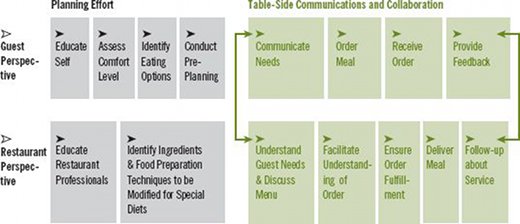
The planning effort for both parties focuses on education and should be completed prior to any interaction between the two. Based upon where guests and restaurants are in the learning curve, their approach to special diets may vary.
As the individual impacted by special diets, you need to understand how different eating establishments approach handling special request meals. It is also important for the restaurant to understand the spectrum of guests’ knowledge about gluten-free diets.
Planning, table-side communications and collaboration are the critical success factors to ensuring that meals are safe for guests to eat. Each of the above steps in the collaborative process have been described within their respective approach sections. Remember, the guidelines and suggested questions to ask are intended to stimulate ideas prior to and during the collaborative process of eating out for each party.
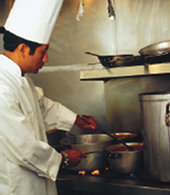
The level of awareness in the restaurant industry concerning special diets is continuing to improve across the globe, with higher levels of understanding in some geographic regions than in others. Also, the number of special menus and nutritional programs are expanding to more and more restaurants, with an increase in health conscious establishments worldwide. These trends can be directly tied to the relationships between restaurants and their guests.
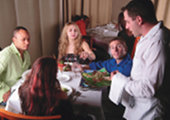
Due to the desire to provide quality service in a highly competitive market, restaurants typically have the best intentions when it comes to guest satisfaction. Many restaurants are flexible with special requests, and make the effort to serve safe and enjoyable meals based upon guests’ specific dietary needs. Hospitality and food service professionals want you, as the guest, to be happy with your experience because they want you to come back often.
The collaboration between guests and restaurants has contributed to advancements across the global special diet communities. We learn from each other, so it is important to take note of any new knowledge that results from each eating experience from both perspectives. Going forward, our collective efforts will continue to increase the understanding of special diets resulting in improved quality of life for those managing gluten-free lifestyles.
Hopefully, reading this book assists you along your learning curve and makes the process easier whether eating out or serving guests around the corner or around the world. Remember, planning, communications and collaboration between guests and restaurants greatly improves safe eating experiences on a regular basis. Enjoy and have fun!